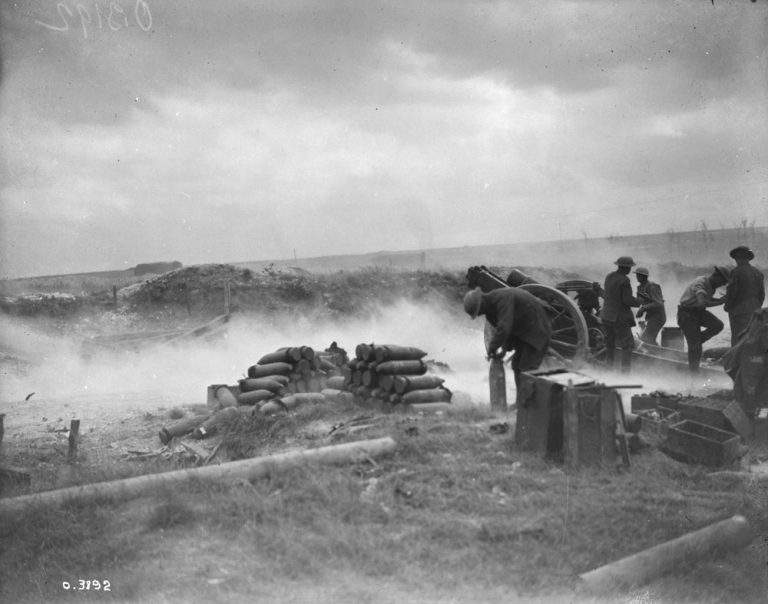close
Learn
Read more about some of the lesser-known battles of Canadians.

tIMELINE
The Vimy Foundation is actively working to ensure that these major battles of the First World War involving Canadians are recalled and our losses commemorated.

May
1915

In May and June of 1915, at Festubert and Givenchy in Northern France, Canadian troops went on the offensive for the first time in the First World War.

June
1916

The high ground between the villages of Hooge and Zwartelleen was by 1916 the only raised area near Ypres still until Allied control. The ground, comprising of Hill 62, Hill 61, and Mont Sorrel were held by the 3rd Division, Canada’s most newly arrived division and as yet untried in battle.

July
1916

On July 1, 1916, the 1st Newfoundland Regiment faced devastating losses at Beaumont Hamel on the first day of the Battle of the Somme. While the casualty list varies, most records indicate that 287 Newfoundlanders were killed in this battle.

September
1916

Aside from the Canadian victory at Flers-Courcelette, the battle also marks the debut of General Sir Douglas Haig’s latest weapon, the tank.

September
1916

After their use at Courcelette, Thiepval was the second site of employment for the new British Mark I tanks.

October
1916

Regina Trench had been part of the original Thiepval objectives. But the attack, in October 1916, devolved to a multi-week slog.

April
1917

Amid sleet, mud and shellfire, the Canadian soldiers fought their way up the Vimy ridge to take the high ground overlooking the Douai plain.

April
1917

Two days after Vimy, an attack was launched on Infantry Hill by the Newfoundland Regiment and the 1st Essex Regiment from the village of Monchy-le-Preux.

April
1917

British General Haig hoped to achieve a redeeming victory by ordering an attack by the Canadians on the “Arleux Loop” at Arleux-en-Gohelle.

May
1917

Fresnoy was taken within several hours, but the Canadian brigades were now in the typical problem facing armies – holding their position.

June
1917

In late June 1917, German forces holding the Souchez River defences began falling back.

August
1917

Currie believed that Hill 70 was the most important objective, since controlling it meant a strong artillery position above the city of Lens.

August
1917

While the Canadian Expeditionary Force fought the Battle of Hill 70, the Newfoundland Regiment was taking part in the Battle of Langemarck.

August
1917

With the success of the Canadian Corps at Hill 70, Currie now turned his eyes to the town behind the hill – Lens.

October
1917

On 9 October 1917, the Royal Newfoundland Regiment took part in the Battle of Poelcappelle, in Flanders, Belgium.

October
1917

The Canadian Corps entered the Battle of Passchendaele in October 1917 after a largely successful spring and summer of victories at Vimy and Hill 70.

November
1917

In November 1917, the Royal Newfoundland Regiment and Canadian Cavalry Brigade take part in the launch of the massive Commonwealth attack on Cambrai.

March
1918

On 21 March 1918, General Ludendorff launched Germany’s massive Spring Offensive, “Kaiserschlacht” (Kaiser’s Battle), along the Western Front.

March
1918

In April 1918, along with the Canadian Cavalry Brigade, the CMMGB would be sent out to harass the advancing Germans and prevent a breakthrough at any cost.

March
1918

30 March 1918: the Canadian Cavalry Brigade set off at a gallop, surging down from Castel, charging across the bridge and up toward Moreuil Wood.

August
1918

Characterised by Ludendorff as “the black day of the German Army”, the first day of the Battle of Amiens set the tone for the last 100 days of the FWW.

August
1918

At Arras, Currie compensated for the lack of surprise by planning a night battle, which began under darkness on 26 August at 3 AM, in the pouring rain.

August
1918

In August 1918, in Chérisy, the German 132rd Infantry Regiment, whose machine guns mowed down the advancing Canadians, resisted fiercely.

September
1918

Known by the German Army as the Wotung Stellung, the Drocourt-Quéant defensive system posed a significant obstacle to the Allies.

September
1918

After retreating from the Drocourt-Quéant Line, the German Army withdrew to their final defensive lines in the Hindenburg system, behind the Canal du Nord.

November
1918

After a general retreat through October 1918, the German Army decided to make a stand in Valenciennes, a strategically-located city.

November
1918

General Currie had orders to capture Mons, so he ordered an attack on the city on November 10, one day before the Armistice.
Other important events happened during the First World War from using planes in war to trench raids.
Explore our educational resources and learn how the battle of Vimy Ridge became a turning point in Canadian History.
View All News
